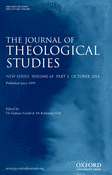-
Views
-
Cite
Cite
Ruth Sheridan, The Pericope Adulterae, the Gospel of John, and the Literacy of Jesus. By Chris Keith., The Journal of Theological Studies, Volume 65, Issue 2, October 2014, Pages 691–694, https://doi.org/10.1093/jts/flu073
Close - Share Icon Share
Extract
This book is a revised version of Keith's doctoral dissertation, undertaken at the University of Edinburgh (2005–8). On the whole, the argument in this book is masterfully developed, and written with clarity and grace. Indeed, one of the key strengths of the book is its coherency of conceptualization, with the cumulative argument flowing so neatly that the reader is never in doubt about what Keith is arguing or why he is arguing it.
Keith's book fills a gap in the literature on the so-called Pericope Adulterae (hereafter PA; John 7:53–8:11) by claiming that Jesus’ action of writing on the ground with his finger (John 8:6–8) is centrally significant to the passage as a whole, to the wider context of John 7–8, and to the impetus behind the eventual insertion of PA into the text of John's Gospel around the third century ce. Whereas previous scholars of PA have argued that the passage derives its importance from its presentation of a compassionate Jesus facing and ‘pardoning’ a female sexual sinner, Keith claims that instead we ought to look to what the interpolator of PA thought he was adding to the Jesus tradition that was otherwise unattested. Keith claims that apart from the twin references to Jesus writing in John 8:6–8, there are no references to a literate Jesus in the canonical tradition. PA's interpolator, therefore, conceived of Jesus’ ability to write as the significant detail needing to be added to the tradition. In doing so, he attributed to Jesus the highest form of literacy: ‘grapho-literacy’, i.e. the skill of compositional writing. While previous scholars have speculated about what Jesus wrote (John 8:6–8), linking the possibilities to the framing story of the adulteress and her accusers, Keith claims that it is more pertinent to the interpolator's agenda simply to indicate that Jesus wrote at all.



